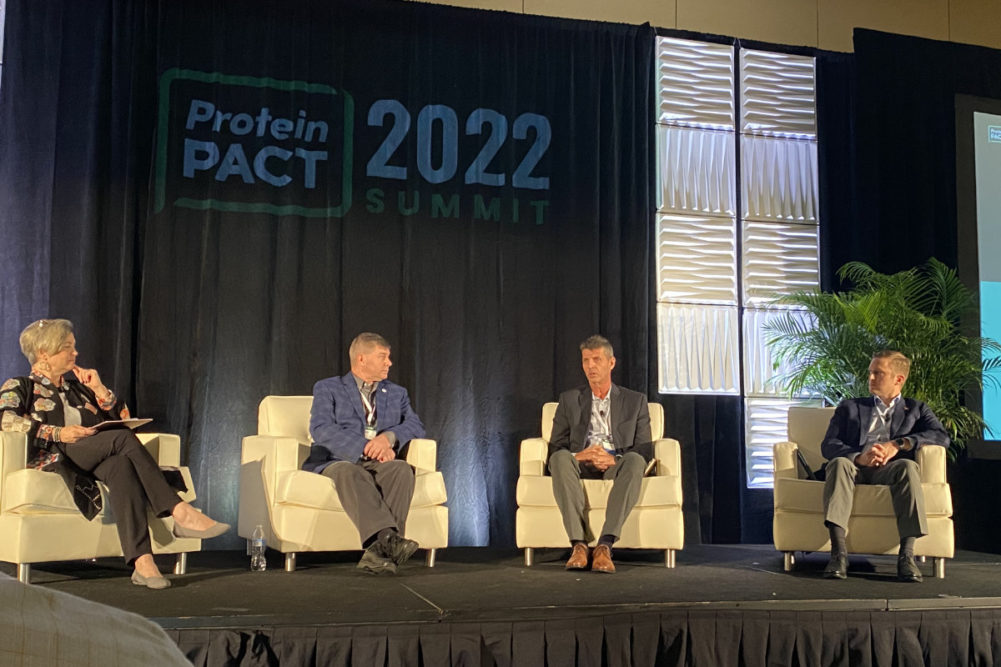ORLANDO, FLA. — Hundreds of leaders in the meat industry gathered in Orlando, Fla., for the second annual Protein PACT Summit to share the early results from this industry initiative led by the North American Meat Institute (NAMI).
Collaboration was one of the main themes highlighted throughout the conference, especially in a panel discussion on Oct. 13 with Bill Even, National Pork Board (NPB) chief executive officer, Bryan Humphreys, CEO of the National Pork Producers Council (NPPC) and Jose Simas, executive vice president of animal business at Elanco Animal Health.
Julie Anna Potts, president and CEO of NAMI, underlined the five pillars of the Protein PACT, and pointed out how the NPB gave the group the encouragement to catch up and partner together.
Even explained how the pork producers of the United States came together with the We Care Ethical Principles adopted by the NPB in 2007 and how that is now extending with the Protein PACT. He explained that principles and practices are part of NPB’s formula of success, but proof has become the third part, with more consumers, industry people and policymakers.
“I think that’s really what ties into Protein PACT is how do we actually demonstrate with data and information that we’re able to pull all those things together and prove it,” Even said. “As they say in Missouri, a little Missouri Show-Me. If you add those three things together, you then end up with the public trust that we’re striving for with Protein PACT.”
Humphreys, who leads NPPC and focuses on government affairs for the pork industry, also talked about its role and how it helps build public trust with the Protein PACT, mainly how the group can be proactive in ensuring the industry continues to collaborate across the board.
“Sometimes our definition of proactive is just simply reacting faster,” he said. “And here the goal is to actually think ahead of what society is going to want. What is happening elsewhere in the world? But also, where are we strong as an industry that we can help guide some of these efforts that Pork Board is putting together and start to be proactive to get ahead of some of these challenges.”
Humphreys also referred to an earlier session that discussed consumer demands and how the pork industry can work to demonstrate how it already fits into We Care and the Protein PACT.
Later in the conversation, Even discussed how one message needs to come through on sustainability, conservation and/or regenerative agriculture and highlight what the industry is already doing in those areas.
“Once the light bulb comes on for producers, that you don’t need to be afraid of engaging in sustainability, because it’s something you’re already doing,” Even said. “Let’s take credit for what you’ve done, and help roll those credits up through the supply chain through storytelling through Protein PACT, and being involved with thought leadership.”
First year data
Another topic throughout the summit was providing data-driven answers for the future.
Following introductions, Kristi Block, strategy director from NAMI, shared data and metrics collected and submitted by participating members of the Protein PACT in the first-ever sector-wide dataset and transparent baselines.
The report noted that 51 total companies reported data for the Protein PACT in the first year, including 15 members with more than 2,000 employees and 25 or 57 companies with at least 300 employees who are members. The goal for the Protein PACT is to have all NAMI members reporting on the metrics by 2030.
NAMI also targeted 2030, when all its members will have approved the Science Based Targets (SBT) to reduce emissions in line with the Paris Climate Agreement goals. The association noted companies that set SBT already, such as Maple Leaf Foods, Tyson and Cargill. Others like JBS, Hormel, National Beef, Smithfield and Marfrig have publicly committed to their targeted goal.
Other data points presented at Protein PACT showed that 25% of reporting establishments have a land use program that addresses land conversion and/or deforestation and 73% of reporting establishments have a watershed-based risk assessment.
Another point by NAMI showed that 83% of reporting establishments have a water withdrawal program with goals by sources to track water use intensity and minimize withdrawal from areas with water stress.
Following the release of data, Block led an update with NAMI members who had participated in the first data collection in 2022.
Alicia Pucky, vice president and chief people & corporate responsibility officer from Fresh Mark Inc., shared some of the best practices she learned in the first year of reporting to the Protein PACT.
“Don’t expect one person to tackle the entire project,” Pucky said of the reporting system. “Have groups that are the experts in that area, look at the information that’s required and be able to pull your policies and items that relate to it.”
Pucky also mentioned devoting specific time to reporting and working with each area’s core leaders to work through their responses.
“Just leave yourself that grace period so you’re not rushing at the end and involve the people that are your experts at your organization,” she said.
Other panelists for that session included Amber Larson, corporate food safety & quality assurance manager of science & technology at American Foods Group and Therese Borneman, director of quality assurance at Jones Dairy Farm.


